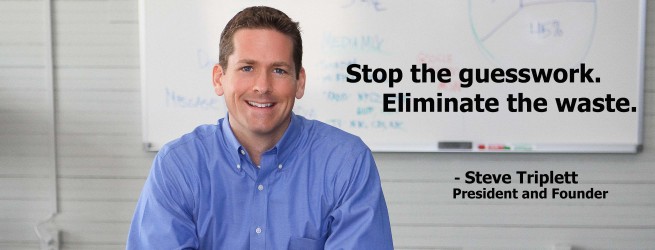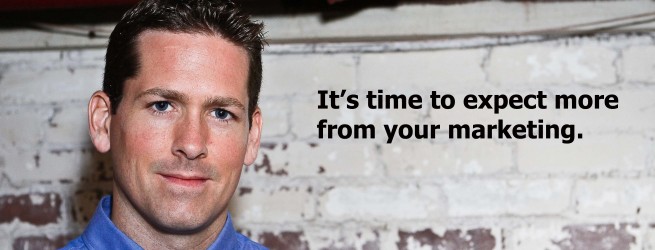Social Media ROI
Yesterday I wrote a post on taking action. The point was that it is very easy to get caught up in endless discussions about how and why to execute a new marketing strategy instead of just doing it. Of course you want to make informed decisions but in many cases deliberation is the enemy of progress.
Social media tools are new but the concept is as old as marketing itself. It’s nothing more than good old-fashioned networking amplified by Internet technology. Customer service. Relationship building. Communication. That’s it.
Businesses often fear new technology. The impulse is to sit on the sidelines waiting for proof that something works. Unfortunately, waiting for someone else to prove a particular strategy or tactic works often means that you’ve missed the opportunity to capitalize on it.
The fact is that many businesses are not only using social media but they are using it profitably. They are trying new things and reaping the rewards of early adoption. They are putting in the time and the effort and they are succeeding because of it.
Want to know what taking action looks like? Still looking for proof that social media isn’t just a bunch of people sharing what they had for lunch? Take a look at this:
Taking Action
 Over and over I’ve heard the old adage that knowledge is power. It’s a philosophy that has served me well.
Over and over I’ve heard the old adage that knowledge is power. It’s a philosophy that has served me well.
I am that guy that is constantly listening to educational CD’s and news programming in the car. And if I’m not meeting a client for lunch you can bet that I will be sitting alone somewhere reading a book or magazine on business, marketing or technology. One of my biggest pet peeves is being stranded somewhere i.e. an airport, restaurant, hotel lobby etc. with nothing to read.
Acquiring knowledge has always been enjoyable for me and for the longest time I believed that it was enough to propel me forward.
Now that I am old enough to have some decent life experience however I have come to the realization that knowledge alone is relatively useless, and in some cases even detrimental, unless it is accompanied by action.
It’s not like this is some profound revelation. It’s obvious. But I can tell you that the number one reason businesses suffer from slow growth or stagnation is a lack of the will to take action.
Due to the nature of my job I constantly come into contact with people searching for ways to improve their businesses. They want more traffic, increased sales, more leads, bigger margins and steady, predictable growth. Ambition is rarely an issue. Taking action almost always is.
Notice that I didn’t say that spending money is the biggest obstacle. Sure, there are plenty of people that are unable or afraid to spend money to solve problems but, again, this is not the nearly as prevalent as the lack of will to take action.
Here’s the deal. The entire world of marketing has changed dramatically in recent years. Actually, the more accurate statement would be: The entire world of what works in marketing has changed dramatically in recent years.
I could go on for days about things like inbound vs. outbound, push vs. pull, flipping funnels, permission marketing and social media but perhaps the most relevant point for business owners is this: You can no longer expect satisfactory results from the strategies and tactics that used to work and the strategies and tactics that work now require a lot more action on your part.
This is a hard pill for many business owners to swallow. Most of them are used to delegating marketing tasks to internal marketing people, advertising agencies or both and then having those people come back with a nicely produced series of ads to run on TV or in a trade magazine.
The budget is approved, the advertising is purchased and then everyone sits back and waits for sales to spike. Problem is – they rarely do anymore.
The new key to success in marketing is value creation. You must give before you get and the giving almost always comes down to creating great content. Publishing content is a lot of work and here’s the rub – you can’t outsource it. At least not all of it. If you do, you’re very likely going to end up with bland, uninspired content that will not be interesting or useful to your customers.
The new world of marketing requires action on the part of everyone involved. If you want to make exponential leaps in lead generation, sales, customer retention and other key metrics, people in your organization must learn to take action by participating reliably in the content creation process.
- This means that the CEO doesn’t start a blog unless she can commit to creating the content on a set schedule.
- This means that you don’t start a Twitter account unless you have a content strategy led by key marketers in your organization.
- This means that you don’t start a newsletter unless you intend to treat it like it like a primary marketing vehicle and commit to producing it consistently, reliably and in perpetuity.
- This means that you don’t leave the content creation process to interns and entry-level staff.
- This means that you devote as many resources to actively listening to your customers as you do to talking/selling to them.
- This means that you do not start a campaign unless you build in a tracking methodology and commit to vigorously monitoring the results.
- This means that, come hell or high water, you take the time to write the ebook, produce the videos, record the audio or publish the articles that will become your primary source of new business leads.
Knowledge is free and widely available. Anyone with an Internet connection can go online and find out what they need to do to succeed in marketing or any other area of life. But no matter how much knowledge you absorb, you’re never going to get anywhere without taking action.
Chances are, you are spending too much time reading, thinking and talking about how to succeed and not enough time actually doing the things that are going to get you there. I see it constantly when working with clients and I catch myself doing it all the time as well. It’s a pervasive problem that affects nearly everyone including the most successful and intelligent leaders among us.
I can tell you from experience that breakthroughs happen when people start taking action without fear or regret. If you’ve been searching for ways to improve your business (or your life) just start taking the steps. Walk the walk. Don’t worry about getting it perfect. Don’t even worry about failing. Just start by committing and taking action. It’s way more satisfying than just coming up with ideas that never see the light of day.
Worth Your Time
Advertising as we know it is quickly heading towards extinction. Many would argue that it’s already extinct. This isn’t as gloomy as it might sound however because it is being replaced by more accessible, affordable, and powerful methods of interacting with your customers. The opportunities are so massive that it is difficult to understate them.
The only way to keep up with these changes is to get engaged with the technology and jump in. It also helps to read like it’s going out of style. Here are two fantastic (and free!) resources that are well worth your time if you have an interest in seeing where it’s all going and why.
This book has been around for a while (published in 2001) but it was definitely ahead of its time and is 100% relevant today. Want to know why your customers are smarter than you? Want to know what to do about it?
FEED: The Razorfish Consumer Experiment
Razorfish is one of the top digital marketing agencies out there. This report reflects their current research into how connected consumers are interacting with social technologies and how it applies to marketers.
Enjoy!
Patience
Looking for a sustainable competitive advantage? Try patience. There are no shortcuts to marketing your business. We live in a marketing culture obsessed with finding the right tactic to boost sales instantly; that one big idea that will immediately define a brand and differentiate it from competitors. Here’s a tip: If you really want a strategy that is unique, one that 90% of your competitors will not be able to duplicate, go with patience.
It’s not surprising that advertisers and agencies continue to search for a quick fix. We live in a world of instant gratification and, to be fair, there was a time when it was possible to get an edge on your competitor using clever offers pushed out to the masses with traditional advertising. So what’s changed? Attention. Today’s consumers are not paying attention to mass market advertising like they used to. There are too many ads in too many places and 99% are irrelevant to the audience that is exposed to them. Yet even with all the news of TV ads getting Tivo-ed, print ads being ignored, and direct mail going straight into to the trash you still see streams of hopeful business owners putting hard earned capital on the line to run a 4 week campaign expecting an immediate 2-to-1 return on the investment. Once they realize it’s not going as planned, they pull the ads and start searching for another magic bullet. It’s the marketing equivalent of yo-yo dieting.
Don’t fall into the trap. Once you have decided what and how you want to communicate with your customers, design a plan that allows you to implement that strategy consistently over a significant period of time. Treat your marketing plan as if it were any other operating expense such as rent, utilities etc. This will enable you to maintain a more consistent presence than your competitors and will allow your messaging to gradually seep into the minds of your customers. Realize that only a tiny fraction of the market is ready to buy your product at any given time. Your goal should be to reach customers well in advance of the transaction so that your brand is the first one they think of when the impulse hits.
Deception

The secret to great online marketing is relevancy. The reason so many advertisers get this wrong is because they try to apply traditional offline strategies to online campaigns. Traditional marketing is based on reach and frequency. The more eyeballs you can aggregate, the better, because only a small portion of the market is ready to buy at any given point in time. You cannot buy TV commercials that are only shown to people that need to buy a vacuum cleaner within the next 48 hours. This theory is completely reversed online. You can very easily – with a search campaign for example – buy ads that are only shown to people actively shopping for nickel-plated sprinkler heads or authentic decorative tumbleweeds. But with all the powerful targeting that online advertising offers, there is plenty of room for abuse.
When online advertisers start sacrificing relevancy for reach, they often end up with deception. This happens to me all the time on Ebay. I search for something like: “Fender Twin Reverb Guitar Amplifier” and receive a page full of results that all appear to be exactly what I’m looking for. But when I start clicking through to the items, I find that half of them are for things like copies of the user manual, promotional posters etc. instead of the actual amplifier itself. This isn’t Ebay’s fault by the way. It happens because merchants craft their listings for related products to appear as though they are the actual item. They are trying to take advantage of product search traffic in order to sell other stuff. It’s dishonest and does nothing but infuriate the very customers they’re trying to attract.
Doc Searls has an interesting post about online advertising that demonstrates why deceptive advertising gimmicks not only do not work, but could very well “pop” the online advertising “bubble.” The message for advertisers that want to get it right is simple – be relevant. The brilliance of online marketing lies in the ability to establish a true dialogue with people that are already interested in your business. It’s a quality, not quantity, based system.
Focus

People that plan advertising campaigns often spend a lot of time focusing on the negotiation and mechanics of purchasing ad space/time. It’s easy to get caught in this trap. Business owners naturally gravitate towards numbers as do the sales reps selling the products. Answering the “how many spots, banners, column inches, clicks etc. can I get for my budget” question seems like a logical way to gauge the kind of deal you are getting. There are two main problems with this philosophy. The first is that it is rarely useful or even possible to make a true value judgment about what you are purchasing using basic calculations such total budget/total units. The second – and most important – reason is that what you do with the advertising you purchase is infinitely more important than how much you actually buy.
Time and time again we have seen business owners or marketing directors spend months negotiating contracts and then scramble once the deal is done to come up with content. The message is almost an afterthought. This is a big mistake because the content of your message is the primary ROI driver. It does not matter how many extra commercials or other freebies you get if the messaging does not initiate a response. On the other hand even a terrible ad buy can often be salvaged if the content is remarkable.
If you are going to spend money marketing your business your focus should be on creating a relevant message that your customers will respond to. Do not make the mistake of spending all your time trying to figure out the nuances of negotiating advertising contracts or, even worse, delegating the task to a lower level employee. Find a professional media planning service that can create an optimal plan for your situation and let them do what they do best – negotiate great deals on your behalf. This frees your time to work on your message to make sure that the money you spend reaching out to your customers comes back to you in the form of increased sales.
Competition
Lots of other companies provide the same product or service that your company does. Many of them have been doing it longer than you. Many of them have more extensive resources than you: More people. More money. More customers. More clout.
This keeps a lot of businesses (and people) from stretching. It’s intimidating to survey the landscape and see a wall of giants. You have a hard time imagining how your business could possibly compete.
Marketing is the great equalizer for underdog businesses. You may not be able to build a bigger building or hire more people, but nothing is stopping you from dominating the space between your customers’ ears.
The trick is learning to see new opportunities within established markets. You can’t own the hill that your competitor does but chances are likely that you can build a new hill that is yours alone.
What’s Your Ideal Client?
We’ll be the first ones to tell you that we’re not right for everyone. You don’t have to poke around this site for long to see that we operate differently from most of the other advertising firms out there. We have pretty strong opinions about marketing and share them openly and honestly.
We operate this way because there’s just too much B.S. floating around in the world of advertising and lots of companies waste unbelievable amounts of money because of it. It’s a big industry with a lot of legacy players that are either unwilling or unable to break free from outdated practices in favor of new ones that are more accountable.
We don’t have any interest in developing theoretical solutions for clients. We like to build systems that create revenue in a manner that is both reliable and measurable.
Our clients come to us when they are fed up with the wish-washy stuff. They are serious about not just sustaining their business, but growing it with ferocity. They are smart enough to know that they don’t know everything and are open to learning and trying new ideas. If that sounds like you, then you’d probably fit right in.
On the other hand, we’re probably not a great fit for you if you believe that:
- Focus groups are the best way to determine the success of an advertising campaign.
- Great brands and great companies are built on brand advertising.
- “Awareness building” should be the primary goal of an advertising campaign.
- Results and spending levels always go hand in hand.
- Advertising is largely a game of luck.
- Successful advertising is based on choosing the right media.
- Great marketing cannot dramatically transform a business.
- Marketing is little more than a necessary evil.
5 Steps to Flawless Advertising
-
Become comfortable with failure.
-
Test – Anything and everything that feels right. Start small.
-
Measure – Everything.
-
Optimize – Based on the data you collect during step #3.
-
Repeat.
Online and Offline Media
There seems to be a lot of confusion out there about the role of offline media in an increasingly online world. Companies are busy creating MySpace pages, YouTube videos, Twitter feeds, writing blogs, running search ads, banner ads, streaming ads etc. because they know that these tools are all part of the revolution that’s going on with online marketing. And all of this is healthy. You should be building, testing, and refining these things because tools like this will become the foundation of your marketing efforts (if they aren’t already). What you want to be careful of however, is becoming so enamored with ‘New’ media that you become completely averse to more traditional forms of advertising.
Being on TV just isn’t as sexy as it used to be is it? What about radio or the newspaper? Why would you even mess with these ancient technologies when everyone knows that the web is where it’s at?
The reason traditional media still makes sense is because there are still benefits to reaching large audiences. The difference now is that instead of trying to close the deal in :30 seconds with a TV spot, you use offline media as the front-end for your online presence. Instead of expecting people to see your commercial and then call up asking to buy something, use the reach of traditional media to drive people to your web assets. You will find that people are much more willing to log on to a website after seeing your commercial than they are to call you for an appointment or walk into your showroom. The other benefit of sending people to the web is that you build a reliable tracking mechanism into your campaign. By simply monitoring the traffic to a campaign-specific landing page you can quickly see what’s working and what isn’t.
It’s critical to be online, just don’t be myopic about it. Make sure you’re making good use of all the tools available to you (new and old) and you’ll get ahead faster.




